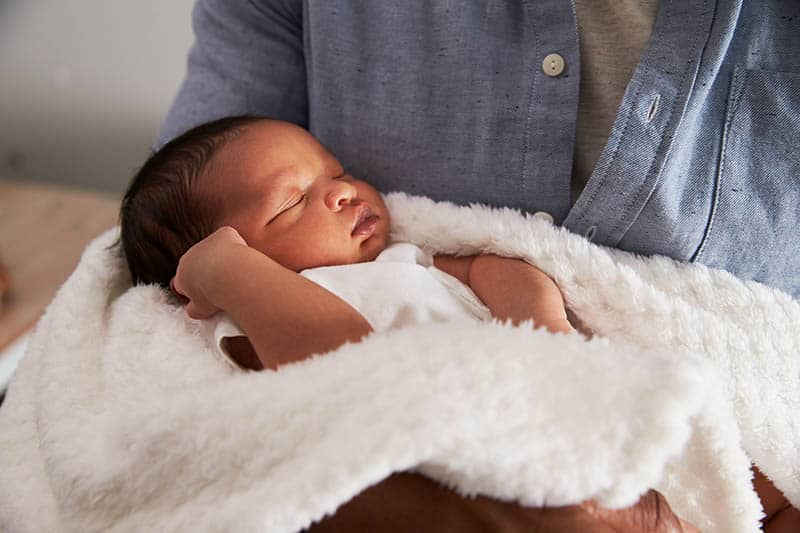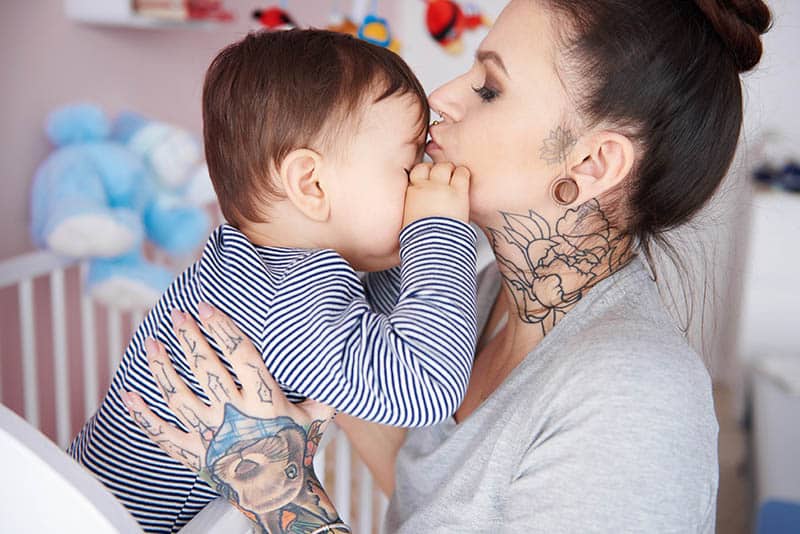Are you struggling with putting your baby to sleep? Are you in a search of the best way to get and keep your little one in bed at night? Then, all you need is a proven sleep training method that will definitely help you – it’s called the pick up put down method.
While there are various other sleep training methods out there, this one is by far the most common. It’s a gentle sleep training method and that’s why it’s favored among the majority of parents.
The PUPD method is preferable for babies who are at around the 7-month mark because, let’s be honest, you can’t exactly train newborns to soothe themselves.
Yes, it’s possible to help your baby fall asleep faster and more independently.
First, I’ll cover what exactly the pick up put down method is, then explain how you can teach your baby self-soothing.
What is the pick up put down method?

Pick up put down sleep training method is a very simple technique that helps you to put your baby to sleep without any sleep associations.
British nurse, Tracy Hogg, describes this method in her book Secrets of the Baby Whisperer: How to Calm, Connect and Communicate with your Baby.
With her experience as a nurse, she wanted to help all mothers around the world to get more easily through that difficult newborn period, and allow us to understand and connect with our little ones.
With the sleep training methods from her book, parents have found putting baby to sleep a non-stressful task.
Okay, so it plays out as follows. After you’re finished with your bedtime routine, you put your baby in her crib and stay in the room for a short time afterward, just to see if she self-soothes to sleep.
You don’t rock or feed her to sleep. Just sit and wait for your baby’s reaction.
Actually, the most important thing is understanding your baby’s needs – listening to her.
If your little one isn’t hungry but is still crying, it likely means that she just needs your comfort because she’s afraid of being alone.
In this case, you then pick her up and cuddle or pat her a little bit, and then put her down in her crib or bassinet again.
If she happens to wake up again in the middle of the night (and of course if it’s not feeding time), you pick up, cuddle and shush her, then put her down again.
Repeat this process as many times as is needed.
In the beginning, it may seem impossible but trust me, it won’t last that long before she adjusts to it and you’ll succeed to help your baby sleep more independently.
This pick up put down sleep training method is recommended and most effective for younger babies, from approximately 4 to 8 months of age.
If you try to use this method with older babies, your presence in the room could possibly upset them and constant picking up and putting down won’t work the way it should.
How does the pick up put down method work?

This method isn’t difficult at all, but it’s not as simple as its name implies.
You can’t just pick up your baby and then put her down in the hope that she’ll fall asleep right away.
There are some steps you need to go through before you get to actually putting your baby to sleep. Let’s go through this sleep guide together.
1. Develop some kind of bedtime routine
Whether you’re going to bath your baby, read her a story, then feed her, or whatever else you feel is good for your baby, you have to establish some form of bedtime routine for your baby.
With this, you can’t really go wrong.
Do whatever you see works for the two of you. The important thing is that you should stick to this routine every night before you put your baby down to sleep.
2. Sing a lullaby
This can also be a part of your bedtime routine.
You can also put on some lullabies, but kids like to hear their parents’ voice, so the better option would be if you could sing or hum it yourself.
If you’re really not one to hold a tune, you can also try to put on some white noise, something that’s known to calm and soothe babies.
Whatever option you choose is irrelevant – the important thing here is that it calms your baby.

3. Cuddle your baby
Babies need to be cuddled – it’s how they feel loved. 7-month-old and younger babies feel secure when one of the parents is in the room.
As soon as you leave the room and they are still awake, they often start crying because they feel abandoned.
Cuddling should also be a part of your bedtime routine.
It will make your little one feel secure, and most definitely help her to self-soothe and sleep throughout the whole night.
4. Listen to your baby
The most important element to this method is understanding and listening to your baby. Pay attention to the night feeds.
If your baby starts crying in the middle of the night, the first thing you should check is whether it’s time for feeding.
If it’s not and your baby is still crying, then pick her up and try to comfort her. If your baby still has sleep problems, you should check if she’s teething or maybe sick.
If you’re confident that nothing is wrong, then your only option is to pick your baby and cuddle, pat, and shush her, then put her back down in the crib.

5. Don’t react as soon as your baby starts fussing
If your baby can’t fall asleep by herself or wakes up after you walk out of the room and starts fussing and crying immediately, don’t pick her up right away.
I know it goes against your very maternal instinct, but if you’re sure that there are no health issues and your baby isn’t hungry, then you don’t have to react to her crying immediately.
6. Give your baby time to settle
The only way your little one is going to learn self-soothing is if you give her some time to settle.
You can walk into the room and show your baby that she isn’t alone, but don’t pick up her the second she starts crying.
The baby will probably stop crying when she realizes that you are there. But of course, if your presence doesn’t calm her down, then you need to go to the next step.

7. Pick up your baby
So you’ve followed all these steps but your baby still isn’t asleep and now you’re probably asking “What do I do next?”
Well, we’ve finally come to the “pick the baby up” part.
If your baby won’t stop crying even when you’re in the same room, you then pick her up and cuddle her for a while.
You can also say something that you think will calm her, like “Don’t worry, sweetie, mommy is here,” or something similar that you think will help to reassure her.
It’s important to know that you should only pick up the baby and try to comfort her a little bit. You shouldn’t feed or rock her to sleep.
8. Put your baby down
After you’ve picked your little one up and comforted her in your own way, now it’s time to proceed to the last step of the pick up put down sleep training method – putting your baby back in the crib.
You should keep in mind that around 4 months of age, babies are dealing with sleep regression and their sleep cycles and sleep habits are changing.
Your baby will probably sleep less or not be able to sleep throughout the whole night. That’s when you’ll need to be the most patient.

9. Repeat the pick up-put down part as many times as needed
Know that it won’t be easy in the beginning. You may have to repeat the pick-up part many times until you succeed in putting your baby to sleep.
Your baby’s sleep routine will also affect your training a lot and that’s why you have to get to know the baby sleep routine before you even start with this method.
Also, pay attention to your baby’s nap time and how many naps she has during the day, as it all affects her night sleep.
10. Let your baby learn the art of self-soothing
Teaching your baby to self-soothe is going to make your life a whole lot easier. You’ll be able to get more sleep and feel more relaxed, too.
If you steadily follow all of these steps, I’m sure you are going to succeed in it. It’s not that difficult, you’ll see – and when the results start showing, you’ll be thankful for this method.

11. Get help from others
Both parents should be equally involved in sleep training. It can be pretty overwhelming and you have every right to ask your partner to help you in the process.
Of course, if none of these tips and methods work for you, you can always seek help and advice from a sleep expert who’ll prepare a special sleep guide for your baby.
How long does it take for the pick up put down method to work?

Unfortunately, this is a question that no one can give you a direct and right answer to. It depends on so many different things.
Just like all adults are different, so are babies. They have different sleep patterns and feeding schedules. It also depends on the age of the baby.
One thing is for sure, if you follow all the steps from above, the method will work.
It’s a well-known fact that you have to be patient with babies, especially when you’re establishing some kind of routine.
Being patient pays off, trust me. Once you teach your baby to fall asleep on her own, he’ll also be able to sleep the whole night. That means you’ll get more rest too, and feel more refreshed the next day.
Other sleep training techniques

The pick up put down method is one of the most gentle methods because it’s natural, and most mothers use it.
However, not all babies will accept this method and success can never be guaranteed.
Just in case PUPD doesn’t work for you and your baby, there are five other successful methods that you can try:
Ferber method: This method doesn’t require you to pick up the baby when you hear her cry. After you finish your bedtime routine, you just put your baby in a crib.
Every 10 to 15 minutes, you check on your baby and if she still isn’t asleep, you are allowed to cuddle her and show her that she isn’t alone.
You can also pat them, but don’t rock or feed them to sleep – remember, falling asleep is their part of the work.
This may be a slower method and you may have to wait for several days to get some results. This method is also known as the check-and-console or progressive waiting method.
CIO or Cry It Out method: This is one of the most unusual sleep training methods. Most parents avoid it because they are afraid of how their baby will react to it.
It’s also known as the controlled crying method.
It starts like all other methods. When you finish your bedtime routine, you put your baby in the crib. Then follows the difficult part.
After you put your baby down, you don’t feed or rock her to sleep, you just have to walk out of the room. If the baby cries, you leave her to cry it out, just as the name of the method says.
This method is difficult for parents because, no matter how much we all try, we just can’t be indifferent to our baby’s tears.
Chair method: This one is very similar to the Ferber method, just in this case, you don’t leave the room until your baby falls asleep.
After you’re done with your bedtime routine, you put your little one in the crib and sit down in a chair that you’ve placed right next to the crib.
You sit there until your baby falls asleep.
If the baby wakes up after a while and it yet isn’t feeding time, you come in the room and continue sitting on the chair until they fall asleep again.
You continue in this fashion, moving the chair a little further from the crib every night.
This method may seem difficult and you may think that your baby will never fall asleep this way, but after some time, you’ll see that your little one will get used to it.
Bedtime-routine fading: This technique is very popular because it doesn’t require any special work. However, it really takes some time before it actually gives any results.
It’s actually very simple. You continue with your bedtime routine and putting your baby to sleep the way you are used to.
The key is that you merely progressively decrease the time of doing whatever you’re doing to put your baby to sleep.
Bedtime-hour fading: For this method, you’ll need to take notes. Write down for several nights the precise time your baby falls asleep.
To be honest, we all want to put our babies to bed earlier, but that’s exactly our mistake. We start the nighttime routine early and then spend a half-hour more with them in an effort to get them to sleep.
After you’ve tracked the exact time your baby falls asleep, you make that the official time you put her to sleep and that’s it. As simple as that.
References:
“Secrets of the Baby Whisperer: How to Calm, Connect and Communicate with your Baby”, Tracy Hogg, 2005.
READ NEXT: How To Sleep Train Your Baby With The Wake And Sleep Method
Like this post? Please share or pin it for later. You can also stay in the loop and follow us on Facebook, Instagram and Pinterest.

This post contains affiliate links. Please see our full disclosure or more info.

